Sphinginae subfamily
Sphingini tribe:
 |
Agrius cingulata,
WO as an unlikely stray Pink-spotted hawkmoth,
This species is a strong migrant and adults nectar from
deep-throated flowers including moonflower (Calonyction aculeatum),
morning glory (Convolvulus), honey suckle (Lonicera)
and petunia (Petunia species).
|
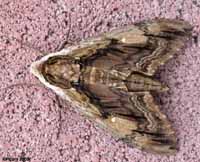 |
Ceratomia amyntor
WO,
the Elm Sphinx or Four-horned Sphinx
The upperside of the forewing is brown with dark brown and white markings including a white costal area near the wing base, dark streaks along the veins,
and a white spot in the cell.
Larvae feed on Elm (Ulmus), birch (Betula), basswood (Tilia), and
cherry (Prunus). |
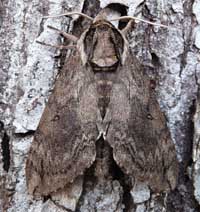 |
The upperside of the forewing is yellowish brown with no white markings, but there are indistinct black lines and dashes. The cell spot is gray with a black outline. The larvae feed in large groups and are much more
spectacular than the moths.
Catalpa is the larval host. |
 |
Ceratomia hageni
USGS,
Hagen's Sphinx or Osage Orange Sphinx
The upperside of the forewing is gray with a green tint and has dark
indistinct wavy lines, and pale gray patches at the wing tip and
along the costa. |
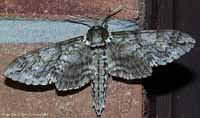 |
The upperside of the forewing is pale brownish gray with wavy black
and white lines and a black-outlined white cell spot. The upperside
of the hindwing is gray with diffuse darker bands.
|
 |
Manduca jasminearum
WO, unlikely, generally more easterly, the Ash Sphinx
The upperside of forewing is gray to grayish brown with a black line running from the middle of the costa to the middle of the outer margin;
the line may be broken near the margin. There is a splash of brown around the cell spot.
The upperside of the hindwing is mostly black, with gray at the lower margin.
|
 |
I suspect if you grow tomatoes, you are likely to encounter Manduca quinquemaculata.
|
 |
Look for three large yellow spots
on each side of the abdomen. The upperside of the forewing is
yellowish brown to deep chocolate brown with a dusting of white
scales and zigzagged black and white lines.
|
 |
If you grow tomatoes, you have probably encountered Manduca sexta
in the larval stage.
Larvae get very large and can strip a tomato plant.
|
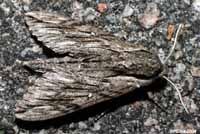 | The upperside of the forewing is gray with indistinct black and
white markings. There is a series of black dashes
from the base to the tip, and a small white cell spot.
|
 |
Sphinx chersis WO, the Northern Ash Sphinx or Great Ash Sphinx
This species might be present in Stone County.
Larval hosts are ash, lilac, privet, cherry, and quaking aspen.
|
 |
The costa rgion in the basal and median areas is light grey and so is the terminal area of the forewing.
The rest of the forewing is dark slatey-grey.
|
 |
Snowberry Sphinx adults fly as a single brood in montane woodlands and along prairie
streamcourses from April to August.
The upperside of the forewing has a narrow black subterminal line
bordered by a white inverted V-shaped line on the outside, and a
black line at the apex. |
Smerinthini Tribe:
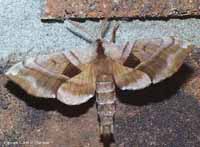 |
The adults are also highly variable; sometimes wings of an individual
may be all one color or may have several colors, ranging from pale to
dark brown, and may have a white or pink tinge. Patterns range from
faint to pronounced.
See the file for the female; she is different.
|
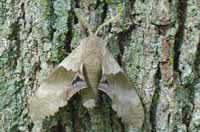 |
Pachysphinx modesta
WO,
the Modest Sphinx or Poplar Sphinx
This moth has a large, heavy body, and females can be remarkably plump.
Forewings are grey and brown with diffuse lines.
|
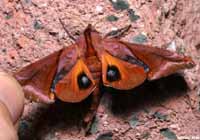 |
Generally, Paonias astylus, the Huckleberry Sphinx (wingspan 55-65 mm),
ranges from Maine south to Florida, west to Missouri and Mississippi. |
 |
Named for the dull grey-blue spot (minus dark pupil) in the hindwing,
this moth has a wide distribution in the eastern United States.
I regularly see them on Prince Edward Island, and they are reported
as far south as Florida. |
 |
Named for the small eye-spot in the hindwing, this moth has a wide
distribution and is probably found in many Missouri counties.
I regularly see them on Prince Edward Island, and they are reported
as far south as Florida.
|
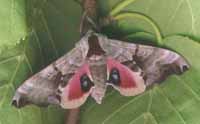 |
This moth is widely distributed and fairly common.
Along the East Coast, it flies from P.E.I. to Florida. |
Macroglossinae subfamily
Dilophonotini tribe:
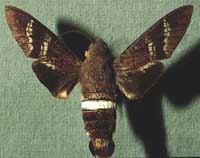 |
Aellopos fadus
WO, unlikely stray, the Titan Sphinx.
The body is dark brown with a wide white stripe across the abdomen.
The wings are dark brown. It is very similar to above species, but the
upperside of the hindwing has
pale patches along the costa and inner margin.
very rare stray
|
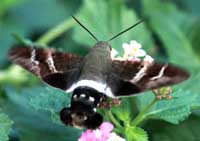 |
Aellopos titan
WO, unlikely stray, the Titan Sphinx.
The body is dark brown with a wide white stripe across the abdomen.
The wings are dark brown. It is very similar to above species, but the
upperside of the hindwing has
pale patches along the costa and inner margin. stray
|
 |
Erinnyis ello
WO, unlikely stray, the Ello Sphinx
The abdomen has very distinct gray and black bands. The female's
forewing upperside is pale gray
with a few dark dots near the outer margin. stray
|
 |
Erinnyis obscura, the Obscure Sphinx,
WO, unlikely stray
During the night adults nectar at flowers, including bouncing bet
(Saponaria officinalis) and Asystasia gangetica beginning at dusk.
July and August are flight times in the southern states.
stray
|
See Hemaris comparison to help distinguish
the next two species.
 |
Hemaris thysbe
USGS/SS, the Hummingbird Clearwing
It is not difficult to see why many gardeners would mistake an
Hemaris thysbe moth for a small hummingbird as it hovers,
sipping nectar from flowers through a long feeding tube.
|
Hemaris thysbe, Lampe, July 30, 2010, Sharon Sargent.
 |
Hemaris diffinis
USGS, the
Snowberry Clearwing or Bumblebee Moth
Adults mimic bumblebees and are quite variable. The wings are basically clear, with dark brown to
brownish-orange veins, bases and edges. The thorax is golden-brown to
dark greenish-brown. The abdomen tends to be dark (black) with 1-2
yellow segments before the tip.
|
Philampelini tribe:
 |
Larvae get large and feed on grape vines and Virginia creeper.
Note the differences between this moth and the Pandorus Sphinx. |
 |
Eumorpha fasciatus
WO, unlikely, the Banded Sphinx
The upperside of the moth is dark pinkish brown. Each forewing has a
lighter brown band along the costa, and sharp pinkish white bands and
streaks. Larvae feed upon primrose-willow, Ludwigia (water primrose)
and other plants in the evening primrose family.
|
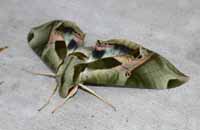 |
If you have Grape or Virginia Creeper nearby, then you probably have
this species.
I often get asked to identify larvae from areas not
previously reported.
|
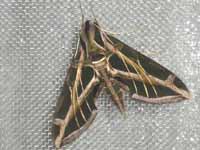 |
Eumorpha vitis
WO, unlikely stray,
the Vine Sphinx
The upperside of the moth is dark pinkish brown. Each forewing has a
lighter brown band along the costa, and sharp pinkish white bands and
streaks. The hindwing has a pink patch on the inner margin. stray
|
Macroglossini tribe:
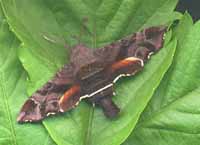 |
This day flier is widely distributed. If you have Virginia Creeper, you
probably have the Nessus Sphinx. Two bright, distinct, narrow yellow
bands are often visible on the abdomen.
|
 |
The lower wings of this hawkmoth are a solid brownish-orange,
matching the body colour.
You will often see this species listed as Darapsa pholus,
especially in older literature. usually more easterly
|
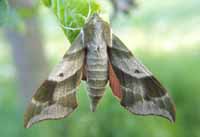 |
Darapsa myron USGS, the Virginia Creeper Sphinx or the Grapevine Sphinx
If you have the
foodplants indicated in the common names, you probably have this
species nearby. The lower wings are orange.
|
 |
If you have hydrangea growing near a stream, then you might have the
Hydrangea Sphinx. rare
|
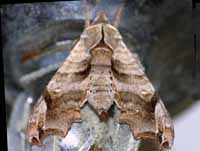 |
The moth's outer margin of the forewing is deeply scalloped.
The upperside is light brown with dark brown markings.
There is a small black and white spot near the tip.
Grape (Vitis), ampelopsis (Ampelopsis), and Virginia creeper
(Parthenocissus) all serve as larval hosts.
|
 |
Hyles lineata
USGS, the White-lined Sphinx
This species has strong migrating tendancies from much further south.
There are records from New Hampshire and Maine.
|
 |
The abdomen may have a pale band running across the rear. The wings are brown. The forewing sometimes has a greenish tint and may have the median area darker.
The lines bordering the median area are curved. The hindwing has a reddish brown border. slight possibility
|
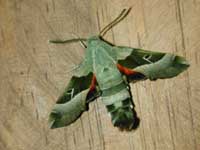 |
The upperside of the forewing is pale gray-green with a deep
green-brown median area and a white dash at the wing tip.
rare
|
 |
This moth is very much under reported across the United States. It
is a rapid day flier so is probably not in too many collections.
Grape is a popular larval host.
|
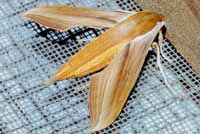 |
The upperside of the forewing is pale brown with lavender-gray at
the base and has dark brown lengthwise lines throughout.
|
|
|


